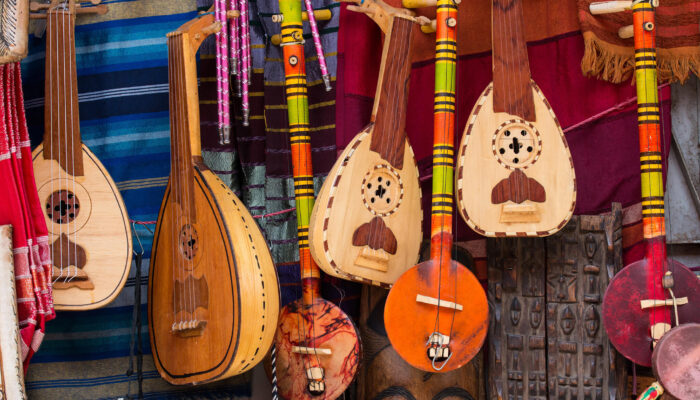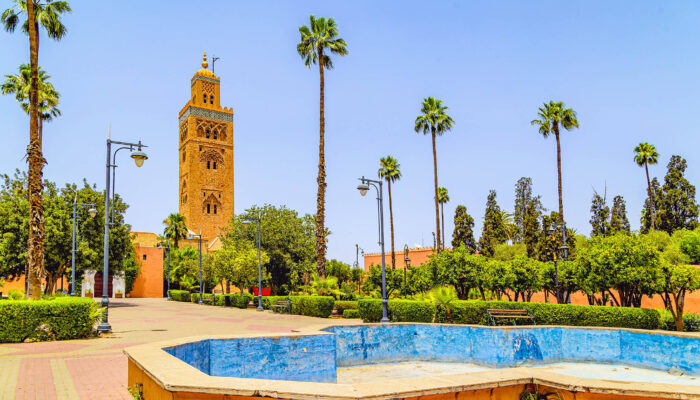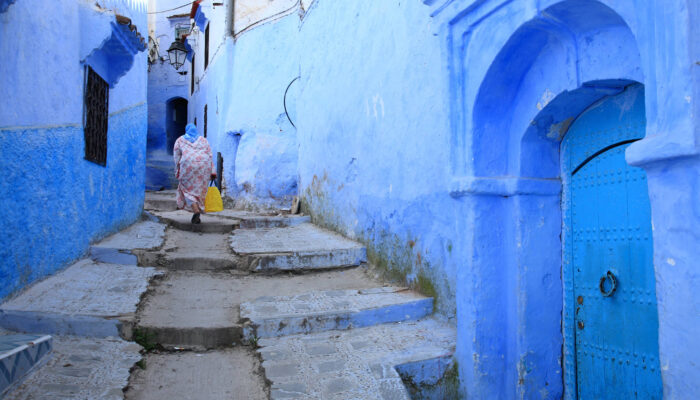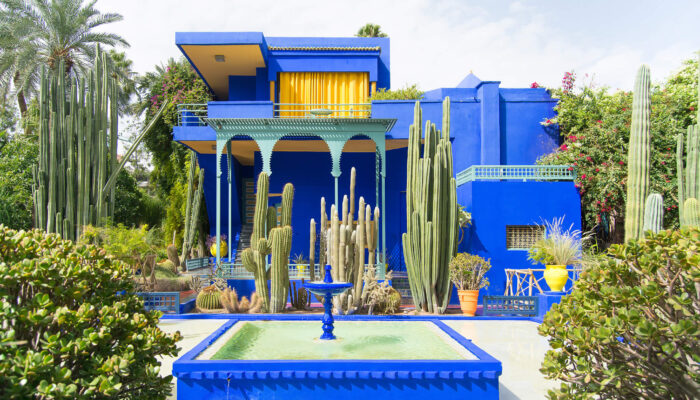Call Us Today
Marrakech, Ouarzazate, Merzouga
Tour Includes:
- A/C (Mercedes VITO) with driver at disposal for all transfers and sightseeing’s
- Accommodations for 5 nights in Deluxe Hotels.
- Accommodations for 1 night in a private Luxury Camp (the white camel Acacia).
- English speaking Tour/Guide throughout
- Transfer by 4*4 Jeep Erfoud / Merzouga / Erfoud.
- 01 dinner included at the camp including camel trek for sunset
- Full day Excursion in Merzouga including lunch
- Entrance Fees to Monuments: Bahia Palace in Marrakech, Ksabah Taourirt, Atlas Studios in Ouarzazate, Majorelle gardens and its Berber museum- Medersa in Fes
- Departure transfer from Hotel in Casablanca-to-Casablanca Airport on last day.
- Taxes & our complete assistance.
| City | Nights | Suggested Accommodations |
|---|---|---|
| Marrakech | 2 | La Mamounia |
| Ouarzazate | 1 | Berber Palace |
| Merzouga | 1 | Luxury Tent |
| Fes | 2 | Palais Faraj Suites & Spa |
Day 01: Marrakech
- Arrival in Marrakech Airport.
- After passing through customs and collecting your luggage, you will be met & greeted by our qualified English-Speaking driver.
- Transfer to the Hotel.
- Check-in & overnight at your hotel.
Day 02: Marrakech
- Breakfast at the Hotel
- Whole day sightseeing tour around the red city: Marrakech is the “pearl of the south’’ founded by the Almoravides Dynasty at the end of the 12 Century.
- Morning discover The “Koutoubia Mosque”, dating back to late 12th century and standing on almost the same spot as an older mosque, Koutoubia Mosque is one of the main symbols of Marrakesh. Although non-Muslim visitors are not allowed inside the grand mosque, the main point of interest lies outside: the soaring minaret. Built from red sandstone, the minaret is one of the best examples of architecture from the Almohad period.
- The Bahia Palace: An ornate former royal palace showcases glorious traditional designs. Colorful tiles cover floors and walls, monumental fountains add to the air of elegance, and graceful arches lead from one area to another. You will also see exquisite wood work and Plaster work.
- The Palace is entered via a horseshoe-arch doorway from the main street, beyond which a long garden path leads to the palace. A minor courtyard leads into the Small Riad, a square courtyard garden divided by walkways along its two central axes and surrounded by richly decorated galleries and chambers
- El Badi Palace, also frequently translated as the “Incomparable Palace” or Badi’ Palace is a ruined palace located in Marrakesh, Morocco. It was commissioned by the sultan Ahmad al-Mansur of the Saadian dynasty a few months after his accession in 1578, with construction and embellishment continuing throughout most of his reign.
- The Saadiens Tombs is a large complex of lavish mausoleums and tombs. Containing the remains of royalty and those held in high regard by the sultan, the site dates back to the 1550s.
- Optional lunch at local restaurant
- Discovery of souks and the medina .
- The main souk stretches out in the center of the medina, from the north of the famous Jemaa el-Fna square to the Ben Youssef Medersa. The central aisles that cross the souks are reserved for sales stalls originally supplied by artisans who work in the adjacent alleys.Local traders and artisans make and sell their production of traditional Moroccan crafts: jewelry, vases, teapots, lanterns, cauldrons, trays …, rugs, leather, body care, clothing, fabrics, fabrics, pottery, perfumes, food, Moroccan pastry , spices ..
- Return back to hotel to rest & fresh up.
- Overnight at your Hotel.
Day 03: Ouarzazate–Tinghir–Erfoud – Merzouga
- Breakfast at your Hotel
- Travel to Ouarzazate via the TizinTichka Pass of the Atlas Mountains.
- First stop will be at Ouarzazate was built as a garrison and administrative center by the French, but today serves as the Hollywood of the Kingdom, center of the country’s film industry, and many movie and TV stars stay in the area when filming. (The Mummy, Lawrence of Arabia, Jesus of Nazareth, Babel, Gladiator and many other biblical motion pictures were filmed in this region). Despite the activity of the filming, the town itself is dusty and basically serves as a central point to make excursions to the surrounding areas.
- Continue to the fortified village of Ait Ben Haddou, the most spectacular fortress in the south of Morocco is listed as a UNESCO World Heritage site, Ait ben haddou kasbah served as a decor for filming international movies as well as a major economic and cultural crossroad since ancient times. It is a striking example of the architecture of the traditional Moroccan South, on the side of a hill at the top of which was a collective attic. The village appears as a set of buildings of earth surrounded with bulwarks, the ksar, which is a type of pre-Saharan traditional housing environment. Houses group together inside its defensive walls strengthened by tours of angle.
- Optional lunch at local restaurant.
- Another Stop in the quaint of Kalaat MGouna is a city in Tinghir Province, Dra-Tafilalt, Morocco. It is most known for the “Roses Festival” which takes place in the city every year in May.
- Then, continue Depart Erfoud and drive through scenic dense palm groves to the inspiring Todra Gorges near Tinghir. Follow the banks of the river, driving through sheer towering walls of rock.
- This afternoon we reach Erfoud, in the southern Ziz Valley, one of the last palmed oases on the rim of the Sahara. It is the gateway to Kasbah trail to the southwest and to the Sahara to the east. A small village at the foot of Djebel, Erfoud, has kept its military origins evoked by its square frame and large avenues with Tamaris at their edges. Erfoud marks the return into greenness and palmed oases, which can be admired from the “Bordj” dominating the area. Almost one million palm trees grow in the Erfoud region alone, so it is not surprising that the date should be its symbol.
- Erfoud is the home to some of the most beautiful scenery in Morocco with ancient Berber Fortress set in palm groves as far as the eye can see.
- Switch to a 4WD vehicle to traverse the spectacular dunes of Erg Chebbi which were featured in the film Lawrence of Arabia. Experience a camel ride and spend time walking among the majestic dunes and witness the magnificent Night under to luxury tent
- BIVOUAC DESCRIPTION
- On arrival at the Camp, you would be greeted in a big nomadic tent (made with camel hair). On the ground: Carpets, tables and traditional chairs & lamps.
- Camels would be waiting for you to experience an unforgettable ride. The «desert ship» would carry you through sand dunes and spectacular scenery.
- It will be followed by a magical guided-tour and the admiration of a star-studded sky.
- Then a bivouac would be set up around a wood fire. You would appreciate the Bedouin traditional dinner.
- Dinner & Overnight at the camp.
Day 04: Merzouga – Erfoud – Midelt – Ifran -Fes
- Earlier in the morning, walking among the majestic dunes and witness the magnificent sunrise to see Merzouga, no one ever regretted getting up at 5 am to witness the unique sunrise: admire and watch the pink disc of the sun appearing over the gigantic dunes.
- Breakfast at your camp.
- Departure to Fes via Midelt is famous for its Handicraft Art, especially the Berber carpets and “Hanbel”. The drive winds through the resort city of Azrou with its Swiss style chalets and native handicraft markets, past cedar forests and broad plains.
- Optional lunch at local restaurant
- Another stop will be at Ifrane, gateway to the Atlas Mountains, an area of Kasbah and Castles and an important mining center. Ifrane is a very surprising little town that will appeal to mountain lovers. Located at an altitude of 1,650 m and 50 km from Fez, it is nicknamed “little Switzerland” with its air of a Swiss village. Luxury chalets and western town planning make it an atypical destination in the Moroccan landscape.
- Continue to Fes.
- Check-in & overnight at your hotel.
Day 05: Fes
- Breakfast at your hotel.
- Start the city tour of Fes founded in the 8th century, is arguably Morocco’s most fascinating city. This metropolis, sited in a valley, was Morocco’s first capital, and is today the kingdom’s intellectual, religious and cultural center. The university here is one of the oldest in the world, and the city’s handicrafts are admirable (look for handmade items like rugs, fabrics, ceramics, leather goods, as well as copper, brass, and silver pieces). Fes street life in the medina may be the most memorable you’ll ever experience. The souks in the medina are an open-air department store, with the spice shops next to the carpet sellers, across from the fishmonger. This is the hub of Moroccan life, filled with vitality.
- Natives of Fes are known as “Fassi”, and have a reputation within Morocco as being excellent businessmen. Generally speaking their origins are divided into 4 distinct categories: descendents of the Moors of Spain, Arab Moslems, Berbers from the High Atlas or the South, and the Islamicized Jews, who came here generations ago to take refuge from persecution in their home countries and subsequently converted to Islam.
- Sightseeing includes the monuments and historical sites of the ancient medina for a walking tour to the Karaouine Mosque and University. You will visit the Attarine Medersas constructed in the early 14th century by the Merinides At the center of the square stands the Nejjarine fountain, which is completely decorated with tiles. They are considered to be the finest examples of geometric ornamentation in the city. In back is the Nejjarine Museum, dedicated to the extraordinary woodwork.
- In the afternoon visit the various markets of the souks and the tanneries with time for shopping.
- Return to your Hotel to rest.
- Overnight at your Hotel.
Day 06: Fes – Volubilis – Rabat – Casablanca
- Breakfast at your Hotel.
- Departure to Casablanca via Volubilis via the ancient Roman ruins of Volubilis. During the period between 45-285 AD the city reached its peak of prosperity as the capital of the province of Mauretania Tingitania, but had in actuality been in existence centuries before the first Roman proconsul arrived. (Entrance fee included). From this tranquil site you can view the Holy City of MoulayI driss – a national pilgrimage site the town holds the tomb of MoulayIdriss – “el Akhbar” (the Great) – the great grandson of the Prophet Mohammed, and the founder of Islam in Morocco. When he escaped Arabia and came to Volubilis in 787 with his loyal slave Rashid, he was accepted as the 6th Caliph. Unfortunately, he was poisoned by his enemies in 792, and in his stead, Rashid ruled as regent until he too was poisoned in 807. Subsequently Moulay Idriss II, assumed rule at the age of 15, and reigned for many years. His tomb as well is in Moulay Idriss. The tombs were rediscovered in the 15th century and became a focus of pilgrimages from the Islamic world.
- Continue to Rabat the city tour of Imperial “garden city” of Rabat The well-planned city consists of broad tree-lined avenues, a landscaped central park, and impressive quarters for the foreign embassies and ministries. See the Kasbah of the Oudayas: It is located at the mouth of the Bou Regreg river opposite Salé. The edifice was built in the 12th century during the reign of the Almohad Caliphate (AD 1121-1269). When the Almohads had captured Rabat and destroyed the kasbah of the Almoravid dynasty in the town, they began reconstructing it in AH 544 / AD 1150. They added a palace and a mosque and named it al-Mahdiyya, after their ancestor al-Mahdi Ibn Tumart. After the death of Yaqub al-Mansur (AH 595 / AD 1199), the kasbah was deserted.
- Optional Lunch at local restaurant.
- Visit the unfinished Hassan Tower and Mosque, and the distinctive and elegant Mausoleum of Mohammed V, revered former King and grandfather of the present King Mohammed VI: are two of Morocco’s most mystical places: one is an incomplete project of majestic proportions and the other stands as a masterpiece of modern Moroccan architecture, holding inside the grand tombs of past kings. Wander through the ruins of columns and enter the ornamental grandeur that is the exquisite mausoleum to discover a part of Moroccan history that will forever remain incomplete.
- Continue to Casablanca.
- Upon arrival start the panoramic tour of Casablanca.This city is the chief port, the financial, commercial and manufacturing center of the country. A modern city with office buildings and big-city traffic, it will not remind you of the eponymous film starring Humphrey Bogart and Ingrid Bergman! The population has grown from approximately 20,000 in the early 1900s to more than four million today (including the suburbs), and is the largest city in Africa. Drive along the wide boulevards, United Nations Square, the residential area of Anfa and Ain Diab.
- Visit of the great Mosque of Hassan II (Outside). Situated on the edge of the Atlantic in the easternmost point of Morocco, the mosque is truly an architectural masterpiece. Designed by the French architect Michel Pinseau, begun in 1980 and completed in 1993, the mosque is the second largest religious edifice in the world (after Mecca) and has the tallest minaret at 689 feet. It can accommodate 25,000 worshippers inside, and an additional 80,000 in the courtyard perimeter.Built on reclaimed land, almost half the surface lies over the Atlantic. King Hassan II was inspired by a verse of the Koran which states “the throne of God was built upon the water”. Although traditional in design and decoration, the mosque also has some very modern features such as an area of glass floor so that when the worshippers kneel above it, they can view the sea below.
- Overnight at the hotel.
Day 07: Departure
- Breakfast at the hotel.
- Transfer to Casablanca airport International approximately 30 minutes drives.
This is a sample itinerary which can be further customized to suit your preference. Prices will be quoted upon request according to the date of travel and the number of passengers in your vehicle.
Sign Up For Our Latest News & Special Deals Sign Up Here






